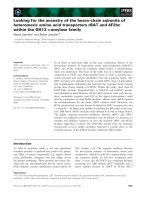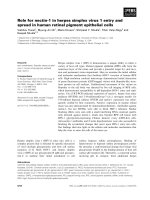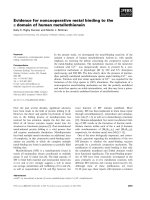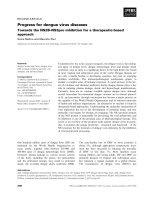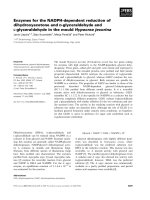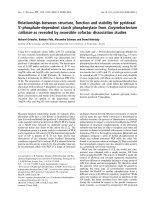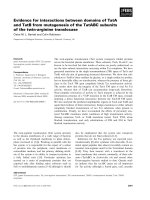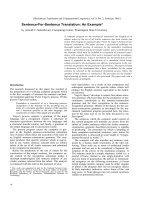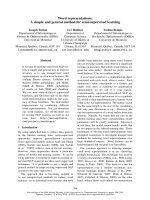Báo cáo khoa học: "Toolkit for Multi-Level Alignment and Information Extraction from Comparable Corpora" pptx
Bạn đang xem bản rút gọn của tài liệu. Xem và tải ngay bản đầy đủ của tài liệu tại đây (240.91 KB, 6 trang )
Proceedings of the 50th Annual Meeting of the Association for Computational Linguistics, pages 91–96,
Jeju, Republic of Korea, 8-14 July 2012.
c
2012 Association for Computational Linguistics
ACCURAT Toolkit for Multi-Level Alignment and
Information Extraction from Comparable Corpora
Mārcis Pinnis
1
, Radu Ion
2
, Dan Ştefănescu
2
, Fangzhong Su
3
,
Inguna Skadiņa
1
, Andrejs Vasiļjevs
1
, Bogdan Babych
3
1
Tilde, Vienības gatve 75a, Riga, Latvia
{marcis.pinnis,inguna.skadina,andrejs}@tilde.lv
2
Research Institute for Artificial Intelligence, Romanian Academy
{radu,danstef}@racai.ro
3
Centre for Translation Studies, University of Leeds
{f.su,b.babych}@leeds.ac.uk
Abstract
The lack of parallel corpora and linguistic
resources for many languages and domains is
one of the major obstacles for the further
advancement of automated translation. A
possible solution is to
exploit comparable
corpora (non-parallel bi- or multi-lingual text
resources) which are much more widely
available than parallel translation data. Our
presented toolkit deals with parallel content
extraction from comparable corpora. It consists
of tools bundled in two workflows: (1)
alignment of comparable documents and
extraction of parallel sentences and (2)
extraction and bilingual mapping of terms and
named entities. The toolkit pairs similar
bilingual comparable documents and extracts
parallel sentences and bilingual terminological
and named entity dictionaries from comparable
corpora. This demonstration focuses on the
English, Latvian, Lithuanian, and Romanian
languages.
Introduction
In recent decades, data-driven approaches have
significantly advanced the development of
machine translation (MT). However, lack of
sufficient bilingual linguistic resources for many
languages and domains is still one of the major
obstacles for further advancement of automated
translation. At the same time, comparable corpora,
i.e., non-parallel bi- or multilingual text resources
such as daily news articles and large knowledge
bases like Wikipedia, are much more widely
available than parallel translation data.
While methods for the use of parallel corpora in
machine translation are well studied (Koehn,
2010), similar techniques for comparable corpora
have not been thoroughly worked out. Only the
latest research has shown that language pairs and
domains with little parallel data can benefit from
the exploitation of comparable corpora (Munteanu
and Marcu, 2005; Lu et al., 2010; Smith et al.,
2010; Abdul-Rauf and Schwenk, 2009 and 2011).
In this paper we present the ACCURAT
toolkit
1
- a collection of tools that are capable of
analysing comparable corpora and extracting
parallel data which can be used to improve the
performance of statistical and rule/example-based
MT systems.
Although the toolkit may be used for parallel
data acquisition for open (broad) domain systems,
it will be most beneficial for under-resourced
languages or specific domains which are not
covered by available parallel resources.
The ACCURAT toolkit produces:
comparable document pairs with
comparability scores, allowing to estimate
the overall comparability of corpora;
parallel sentences which can be used as
additional parallel data sources for
statistical translation model learning;
1
91
terminology dictionaries ― this type of
data is expected to improve domain-
dependent translation;
named entity dictionaries.
The demonstration showcases two general use
case scenarios defined in the toolkit: “parallel data
mining from comparable corpora” and “named
entity/terminology extraction and mapping from
comparable corpora”.
The next section provides a general overview of
workflows followed by descriptions of methods
and tools integrated in the workflows.
1 Overview of the Workflows
The toolkit’s tools are integrated within two
workflows (visualised in Figure 1).
Figure 1. Workflows of the ACCURAT toolkit.
The workflow for parallel data mining from
comparable corpora aligns comparable corpora in
the document level (section 2.1). This step is
crucial as the further steps are computationally
intensive. To minimise search space, documents
are aligned with possible candidates that are likely
to contain parallel data. Then parallel sentence
pairs are extracted from the aligned comparable
corpora (section 2.2).
The workflow for named entity (NE) and
terminology extraction and mapping from
comparable corpora extracts data in a dictionary-
like format. Providing a list of document pairs, the
workflow tags NEs or terms in all documents using
language specific taggers (named entity
recognisers (NER) or term extractors) and
performs multi-lingual NE (section 2.3) or term
mapping (section 2.4), thereby producing bilingual
NE or term dictionaries. The workflow also
accepts pre-processed documents, thus skipping
the tagging process.
Since all tools use command line interfaces, task
automation and workflow specification can be
done with simple console/terminal scripts. All
tools can be run on the Windows operating system
(some are also platform independent).
2 Tools and Methods
This section provides an overview of the main
tools and methods in the toolkit. A full list of tools
is described in ACCURAT D2.6. (2011).
2.1 Comparability Metrics
We define comparability by how useful a pair of
documents is for parallel data extraction. The
higher the comparability score, the more likely two
documents contain more overlapping parallel data.
The methods are developed to perform lightweight
comparability estimation that minimises search
space of relatively large corpora (e.g., 10,000
documents in each language). There are two
comparability metric tools in the toolkit: a
translation based and a dictionary based metric.
The Translation based metric (Su and Babych,
2012a) uses MT APIs for document translation
into English. Then four independent similarity
feature functions are applied to a document pair:
Lexical feature ― both documents are pre-
processed (tokenised, lemmatised, and
stop-words are filtered) and then
vectorised. The lexical overlap score is
calculated as a cosine similarity function
over the vectors of two documents.
Structural feature ― the difference of
sentence counts and content word counts
(equally interpolated).
Keyword feature ― the cosine similarity
of top 20 keywords.
NE feature ― the cosine similarity of NEs
(extracted using Stanford NER).
These similarity measures are linearly combined in
a final comparability score. This is implemented by
a simple weighted average strategy, in which each
92
type of feature is associated with a weight
indicating its relative confidence or importance.
The comparability scores are normalised on a scale
of 0 to 1, where a higher comparability score
indicates a higher comparability level.
The reliability of the proposed metric has been
evaluated on a gold standard of comparable
corpora for 11 language pairs (Skadiņa et al.,
2010). The gold standard consists of news articles,
legal documents, knowledge-base articles, user
manuals, and medical documents. Document pairs
in the gold standard were rated by human judges as
being parallel, strongly comparable, or weakly
comparable. The evaluation results suggest that the
comparability scores reliably reflect comparability
levels. In addition, there is a strong correlation
between human defined comparability levels and
the confidence scores derived from the
comparability metric, as the Pearson R correlation
scores vary between 0.966 and 0.999, depending
on the language pair.
The Dictionary based metric (Su and Babych,
2012b) is a lightweight approach, which uses
bilingual dictionaries to lexically map documents
from one language to another. The dictionaries are
automatically generated via word alignment using
GIZA++ (Och and Ney, 2000) on parallel corpora.
For each word in the source language, the top two
translation candidates (based on the word
alignment probability in GIZA++) are retrieved as
possible translations into the target language. This
metric provides a much faster lexical translation
process, although word-for-word lexical mapping
produces less reliable translations than MT based
translations. Moreover, the lower quality of text
translation in the dictionary based metric does not
necessarily degrade its performance in predicting
comparability levels of comparable document
pairs. The evaluation on the gold standard shows a
strong correlation (between 0.883 and 0.999)
between human defined comparability levels and
the confidence scores of the metric.
2.2 Parallel Sentence Extractor from
Comparable Corpora
Phrase-based statistical translation models are
among the most successful translation models that
currently exist (Callison-Burch et al., 2010).
Usually, phrases are extracted from parallel
corpora by means of symmetrical word alignment
and/or by phrase generation (Koehn et al., 2003).
Our toolkit exploits comparable corpora in order to
find and extract comparable sentences for SMT
training using a tool named LEXACC (Ştefănescu
et al., 2012).
LEXACC requires aligned document pairs (also
m to n alignments) for sentence extraction. It also
allows extraction from comparable corpora as a
whole; however, precision may decrease due to
larger search space.
LEXACC scores sentence pairs according to five
lexical overlap and structural matching feature
functions. These functions are combined using
linear interpolation with weights trained for each
language pair and direction using logistic
regression. The feature functions are:
a lexical (translation) overlap score for
content words (nouns, verbs, adjectives,
and adverbs) using GIZA++ (Gao and
Vogel, 2008) format dictionaries;
a lexical (translation) overlap score for
functional words (all except content
words) constrained by the content word
alignment from the previous feature;
the alignment obliqueness score, a measure
that quantifies the degree to which the
relative positions of source and target
aligned words differ;
a score indicating whether strong content
word translations are found at the
beginning and the end of each sentence in
the given pair;
a punctuation score which indicates
whether the sentences have identical
sentence ending punctuation.
For different language pairs, the relevance of
the individual feature functions differ. For
instance, the locality feature is more important for
the English-Romanian pair than for the English-
Greek pair. Therefore, the weights are trained on
parallel corpora (in our case - 10,000 pairs).
LEXACC does not score every sentence pair in
the Cartesian product between source and target
document sentences. It reduces the search space
using two filtering steps (Ştefănescu et al., 2012).
The first step makes use of the Cross-Language
Information Retrieval framework and uses a search
engine to find sentences in the target corpus that
are the most probable translations of a given
sentence. In the second step (which is optional),
93
the resulting candidates are further filtered, and
those that do not meet minimum requirements are
eliminated.
To work for a certain language pair, LEXACC
needs additional resources: (i) a GIZA++-like
translation dictionary, (ii) lists of stop-words in
both languages, and (iii) lists of word suffixes in
both languages (used for stemming).
The performance of LEXACC, regarding
precision and recall, can be controlled by a
threshold applied to the overall interpolated
parallelism score. The tool has been evaluated on
news article comparable corpora. Table 1 shows
results achieved by LEXACC with different
parallelism thresholds on automatically crawled
English-Latvian corpora, consisting of 41,914
unique English sentences and 10,058 unique
Latvian sentences.
Threshold
Aligned
pairs
Precision
Useful
pairs
0.25 1036 39.19% 406
0.3 813 48.22% 392
0.4 553 63.47% 351
0.5 395 76.96% 304
0.6 272 84.19% 229
0.7 151 88.74% 134
0.8 27 88.89% 24
0.9 0 - 0
Table 1. English-Latvian parallel sentence extraction
results on a comparable news corpus.
Threshold
Aligned
pairs
Precision Useful pairs
0.2 2324 10.32% 240
0.3 1105 28.50% 315
0.4 722 53.46% 386
0.5 532 89.28% 475
0.6 389 100% 389
0.7 532 100% 532
0.8 386 100% 386
0.9 20 100% 20
Table 2. English-Romanian parallel sentence extraction
results on a comparable news corpus.
Table 2 shows results for English-Romanian on
corpora consisting of 310,740 unique English and
81,433 unique Romanian sentences.
Useful pairs denote the total number of parallel
and strongly comparable sentence pairs (at least
80% of the source sentence is a translation in the
target sentence). The corpora size is given only as
an indicative figure, as the amount of extracted
parallel data greatly depends on the comparability
of the corpora.
2.3 Named Entity Extraction and Mapping
The second workflow of the toolkit allows NE and
terminology extraction and mapping. Starting with
named entity recognition, the toolkit features the
first NER systems for Latvian and Lithuanian
(Pinnis, 2012). It also contains NER systems for
English (through an OpenNLP NER
2
wrapper) and
Romanian (NERA). In order to map named entities,
documents have to be tagged with NER systems
that support MUC-7 format NE SGML tags.
The toolkit contains the mapping tool NERA2.
The mapper requires comparable corpora aligned
in the document level as input. NERA2 compares
each NE from the source language to each NE
from the target language using cognate based
methods. It also uses a GIZA++ format statistical
dictionary to map NEs containing common nouns
that are frequent in location names. This approach
allows frequent NE mapping if the cognate based
method fails, therefore, allowing increasing the
recall of the mapper. Precision and recall can be
tuned with a confidence score threshold.
2.4 Terminology Mapping
During recent years, automatic bilingual term
mapping in comparable corpora has received
greater attention in light of the scarcity of parallel
data for under-resourced languages. Several
methods have been applied to this task, e.g.,
contextual analysis (Rapp, 1995; Fung and
McKeown, 1997) and compositional analysis
(Daille and Morin, 2008). Symbolic, statistical, and
hybrid techniques have been implemented for
bilingual lexicon extraction (Morin and
Prochasson, 2011).
Our terminology mapper is designed to map
terms extracted from comparable or parallel
2
Open NLP -
94
documents. The method is language independent
and can be applied if a translation equivalents table
exists for a language pair. As input, the application
requires term-tagged bilingual corpora aligned in
the document level.
The toolkit includes term-tagging tools for
English, Latvian, Lithuanian, and Romanian, but
can be easily extended for other languages if a
POS-tagger, a phrase pattern list, a stop-word list,
and an inverse document frequency list (calculated
on balanced corpora) are available.
The aligner maps terms based on two criteria
(Pinnis et al., 2012; Ştefănescu, 2012): (i) a
GIZA++-like translation equivalents table and (ii)
string similarity in terms of Levenshtein distance
between term candidates. For evaluation, Eurovoc
(Steinberger et al., 2002) was used. Tables 4 and 5
show the performance figures of the mapper for
English-Romanian and English-Latvian.
Threshold P R F-measure
0.3 0.562 0.194 0.288
0.4 0.759 0.295 0.425
0.5 0.904 0.357 0.511
0.6 0.964 0.298 0.456
0.7 0.986 0.216 0.359
0.8 0.996 0.151 0.263
0.9 0.995 0.084 0.154
Table 3. Term mapping performance for English-
Romanian.
Threshold P R F-measure
0.3 0.636 0.210 0.316
0.4 0.833 0.285 0.425
0.5 0.947 0.306 0.463
0.6 0.981 0.235 0.379
0.7 0.996 0.160 0.275
0.8 0.996 0.099 0.181
0.9 0.997 0.057 0.107
Table 4. Term mapping performance for English-
Latvian.
3 Conclusions and Related Information
This demonstration paper describes the
ACCURAT toolkit containing tools for multi-level
alignment and information extraction from
comparable corpora. These tools are integrated in
predefined workflows that are ready for immediate
use. The workflows provide functionality for the
extraction of parallel sentences, bilingual NE
dictionaries, and bilingual term dictionaries from
comparable corpora.
The methods, including comparability metrics,
parallel sentence extraction and named entity/term
mapping, are language independent. However, they
may require language dependent resources, for
instance, POS-taggers, Giza++ translation
dictionaries, NERs, term taggers, etc.
3
The ACCURAT toolkit is released under the
Apache 2.0 licence and is freely available for
download after completing a registration form
4
.
Acknowledgements
The research within the project ACCURAT
leading to these results has received funding from
the European Union Seventh Framework
Programme (FP7/2007-2013), grant agreement no
248347.
References
Sadaf Abdul-Rauf and Holger Schwenk. On the use of
comparable corpora to improve SMT performance.
EACL 2009: Proceedings of the 12th conference of
the European Chapter of the Association for
Computational Linguistics, Athens, Greece, 16-23.
Sadaf Abdul-Rauf and Holger Schwenk. 2011. Parallel
sentence generation from comparable corpora for
improved SMT. Machine Translation, 25(4): 341-
375.
ACCURAT D2.6 2011. Toolkit for multi-level
alignment and information extraction from
comparable corpora ().
Dan Gusfield. 1997. Algorithms on strings, trees and
sequences. Cambridge University Press.
Chris Callison-Burch, Philipp Koehn, Christof Monz,
Kay Peterson, Mark Przybocki and Omar Zaidan.
2010. Findings of the 2010 Joint Workshop on
Statistical Machine Translation and Metrics for
Machine Translation. Proceedings of the Joint Fifth
Workshop on Statistical Machine Translation and
MetricsMATR, 17-53.
Béatrice Daille and Emmanuel Morin. 2008. Effective
compositional model for lexical alignment.
Proceedings of the 3
rd
International Joint Conference
3
Full requirements are defined in the documentation of each
tool (ACCURAT D2.6, 2011).
4
95
on Natural Language Processing, Hyderabad, India,
95-102.
Franz Josef Och and Hermann Ney. 2000. Improved
statistical alignment models. Proceedings of the 38th
Annual Meeting of the Association for
Computational Linguistics, 440-447.
Pascale Fung and Kathleen Mckeown. 1997. Finding
terminology translations from non-parallel corpora.
Proceedings of the 5th Annual Workshop on Very
Large Corpora, 192-202.
Qin Gao and Stephan Vogel. 2008. Parallel
implementations of a word alignment tool.
Proceedings of ACL-08 HLT: Software Engineering,
Testing, and Quality Assurance for Natural Language
Processing, June 20, 2008. The Ohio State
University, Columbus, Ohio, USA, 49-57.
Philipp Koehn, Franz Josef Och, and Daniel Marcu.
2003. Statistical phrase-based translation.
Proceedings of the Human Language Technology and
North American Association for Computational
Linguistics Conference (HLT/NAACL), May 27-
June 1, Edmonton, Canada.
Philip Koehn. 2010. Statistical machine translation,
Cambridge University Press.
Bin Lu, Tao Jiang, Kapo Chow and Benjamin K. Tsou.
2010. Building a large English-Chinese parallel
corpus from comparable patents and its experimental
application to SMT. Proceedings of the 3
rd
workshop
on building and using comparable corpora: from
parallel to non-parallel corpora, Valletta, Malta, 42-
48.
Dragoş Ştefan Munteanu and Daniel Marcu. 2006.
Extracting parallel sub-sentential fragments from
nonparallel corpora. ACL-44: Proceedings of the 21st
International Conference on Computational
Linguistics and the 44th annual meeting of the
Association for Computational Linguistics,
Morristown, NJ, USA, 81-88.
Emmanuel Morin and Emmanuel Prochasson. 2011.
Bilingual lexicon extraction from comparable
corpora enhanced with parallel corpora. ACL HLT
2011, 27-34.
Mārcis Pinnis. 2012. Latvian and Lithuanian named
entity recognition with TildeNER. Proceedings of the
8
th
international conference on Language Resources
and Evaluation (LREC 2012), Istanbul, Turkey.
Mārcis Pinnis, Nikola Ljubešić, Dan Ştefănescu, Inguna
Skadiņa, Marko Tadić, Tatiana Gornostay. 2012.
Term extraction, tagging, and mapping tools for
under-resourced languages. Proceedings of the 10
th
Conference on Terminology and Knowledge
Engineering (TKE 2012), June 20-21, Madrid, Spain.
Reinhard Rapp. 1995. Identifying word translations in
non-parallel texts. Proceedings of the 33
rd
annual
meeting on Association for Computational
Linguistics, 320-322.
Jason R. Smith, Chris Quirk, and Kristina Toutanova.
2010. Extracting parallel sentences from comparable
corpora using document level alignment. Proceedings
of NAACL 2010, Los Angeles, USA.
Dan Ştefănescu. 2012. Mining for term translations in
comparable corpora. Proceedings of the 5
th
Workshop on Building and Using Comparable
Corpora (BUCC 2012) to be held at the 8
th
edition of
Language Resources and Evaluation Conference
(LREC 2012), Istanbul, Turkey, May 23-25, 2012.
Ralf Steinberger, Bruno Pouliquen and Johan Hagman.
2002. Cross-lingual document similarity calculation
using the multilingual thesaurus Eurovoc.
Proceedings of the 3
rd
International Conference on
Computational Linguistics and Intelligent Text
Processing (CICLing '02), Springer-Verlag London,
UK, ISBN:3-540-43219-1.
Inguna Skadiņa, Ahmet Aker, Voula Giouli, Dan Tufis,
Rob Gaizauskas, Madara Mieriņa and Nikos
Mastropavlos. 2010. Collection of comparable
corpora for under-resourced languages. In
Proceedings of the Fourth International Conference
Baltic HLT 2010, IOS Press, Frontiers in Artificial
Intelligence and Applications, Vol. 219, pp. 161-168.
Fangzhong Su and Bogdan Babych. 2012a.
Development and application of a cross-language
document comparability metric. Proceedings of the
8
th
international conference on Language Resources
and Evaluation (LREC 2012), Istanbul, Turkey.
Fangzhong Su and Bogdan Babych. 2012b. Measuring
comparability of documents in non-parallel corpora
for efficient extraction of (semi-) parallel translation
equivalents. Proceedings of EACL'12 joint
workshop on Exploiting Synergies between
Information Retrieval and Machine Translation
(ESIRMT) and Hybrid Approaches to Machine
Translation (HyTra), Avignon, France.
Dan Ştefănescu, Radu Ion and Sabine Hunsicker. 2012.
Hybrid parallel sentence mining from comparable
corpora. Proceedings of the 16th Conference of the
European Association for Machine Translation
(EAMT 2012), Trento, Italy.
96
